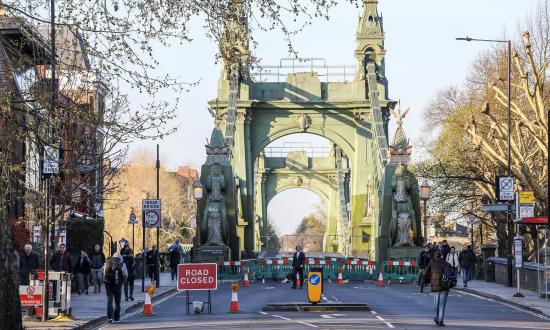Residents Say Wardens Failed To Control Buses Crossing Hammersmith Bridge
TfL spent nearly £900,000 trying to limit to one at a time

TfL spent nearly £900,000 hiring wardens who were accused of failing to control bus traffic on Hammersmith Bridge before structural defects forced it to closure.
Private bridge wardens were stationed on both sides of the Grade II-listed crossing from May 2016, before TfL started using its own staff from October that year.
Their job was to make sure only one single-decker bus drove over the 132-year-old Victorian bridge in each direction at a time. The was due to fears about how much weight it could carry, and prior to 2015, buses weighing nine tonnes used it 1,800 times per day.
It closed indefinitely to all but pedestrians and cyclists on April 10, when sensors detected microfractures in the cast iron pedestals that fix the bridge to riverbed. The council says it is determined to “get the bridge back up and running”.
But despite the wardens’ supervision, local residents say more buses could be seen using the bridge simultaneously during rush hour.
Freedom of information requests show TfL spent £23,800 per month on four wardens and a supervisor deployed on the bridge since October 2016. TfL could not say how much it spent for the first five months on hiring the agency staff. But it means the transport authority has, to date, spent up to £880,600 on the bridge wardens, and at least £761,000, depending on whether agency staff were paid less than TfL staff.
TfL is expected to overspend by £742 million this year, but will continue paying for bridge wardens — now tasked with stopping motorbikes from crossing it — until it fully reopens.
A Hammersmith Bridge Road resident who asked not to be named said: “During rush hour when all the traffic was backed up you would definitely see two buses on the bridge at once.
“The impression I got was wardens would wait till there was no bus in sight, then let another one through. But the wardens were based quite far back [from the bridge] so they couldn’t always see.”
Immediately after the bridge closed, Hammersmith and Fulham Council released a statement suggesting the wardens’ failure to control the bus traffic had been a factor in its decline. The council’s website also has records of an incident in September 2016, when the wardens were said to have abandoned their posts.
Yesterday, council leader Stephen Cowan said engineers are still working to fully diagnose the full extent of the damage to the bridge.
“What we want is a scientific explanation of how the microfractures appeared, because they shocked everybody,” councillor Cowan said. “Mostly they’re in the pedestals that hold the suspension bit of the bridge.
“There was a lot of speculation around in the early days about what caused it [the damage]. But the truth is no one had a scientific understanding of what caused it because no one had done anything until we started to review it in 2015.”
TfL took over management of the bridge in 2015. And there were several months before wardens were hired that TfL operated barriers, which bus drivers opened using a swipe card.
“When the barriers were there you would sometimes get buses tailgating to get passed at once,” said the woman, who was also a Hammersmith Bridge Society member. “And the barriers were always breaking. One of the barriers ended up in our garden, not by accident I imagine.”
Mr Cowan also recalled an incident when “under Boris Johnson, some of those wardens ripped off the barriers… When the new administration came into City Hall that stopped.”
A TfL spokesperson said: “We brought in a staffed gating system in 2016 to manage the flow of buses on the 132-year-old bridge. We also impressed the restriction on bus operators. This played a key role in reducing the number of buses on the bridge at any time and also stopped other overweight vehicles.
“The underlying issue with the bridge relates to its age and the volume of vehicles using it. We are working closely with the council’s engineers to finalise a plan for repairing the bridge as soon as possible.”
The local resident added: “The wardens still patrol the bridge to stop motorbikes crossing it. But sometimes the motorbikes just accelerate straight at them and get through. The wardens aren’t expected to lay down in the road to stop them.”
Mr Cowan revealed at a town hall meeting yesterday that by late September the council will have a full schedule of the work needed to fix the bridge, and how much it will cost. He said the council has been told the work could take “up to three years”, and that they and TfL will bid for repairs funding from the Government.
Last month, Transport for London announced the rejigging of local bus services due to the bridge closure. You can read the details here.
The bridge remains open to cyclists and pedestrians.
Owen Sheppard - Local Democracy Reporter
June 19, 2019